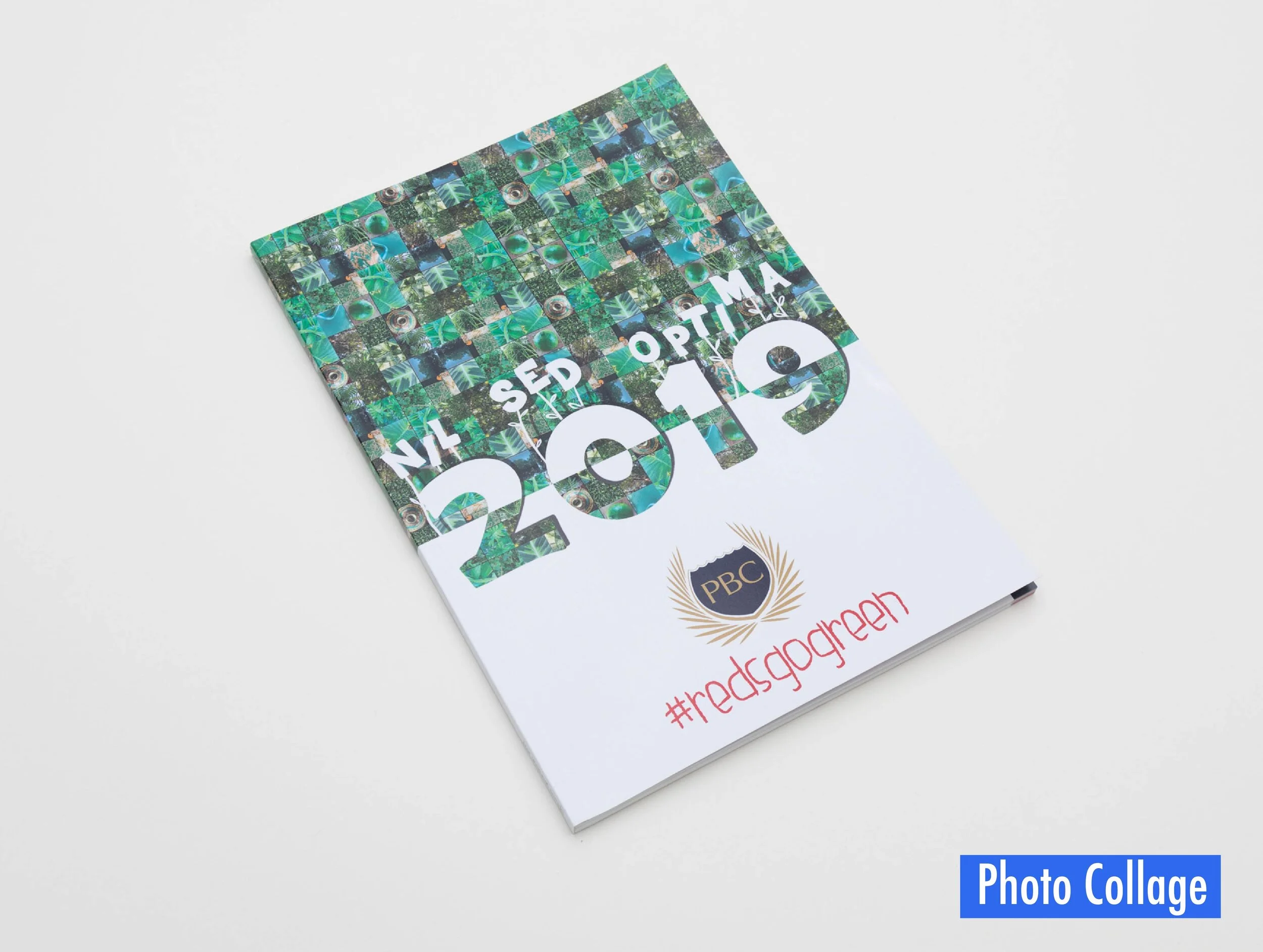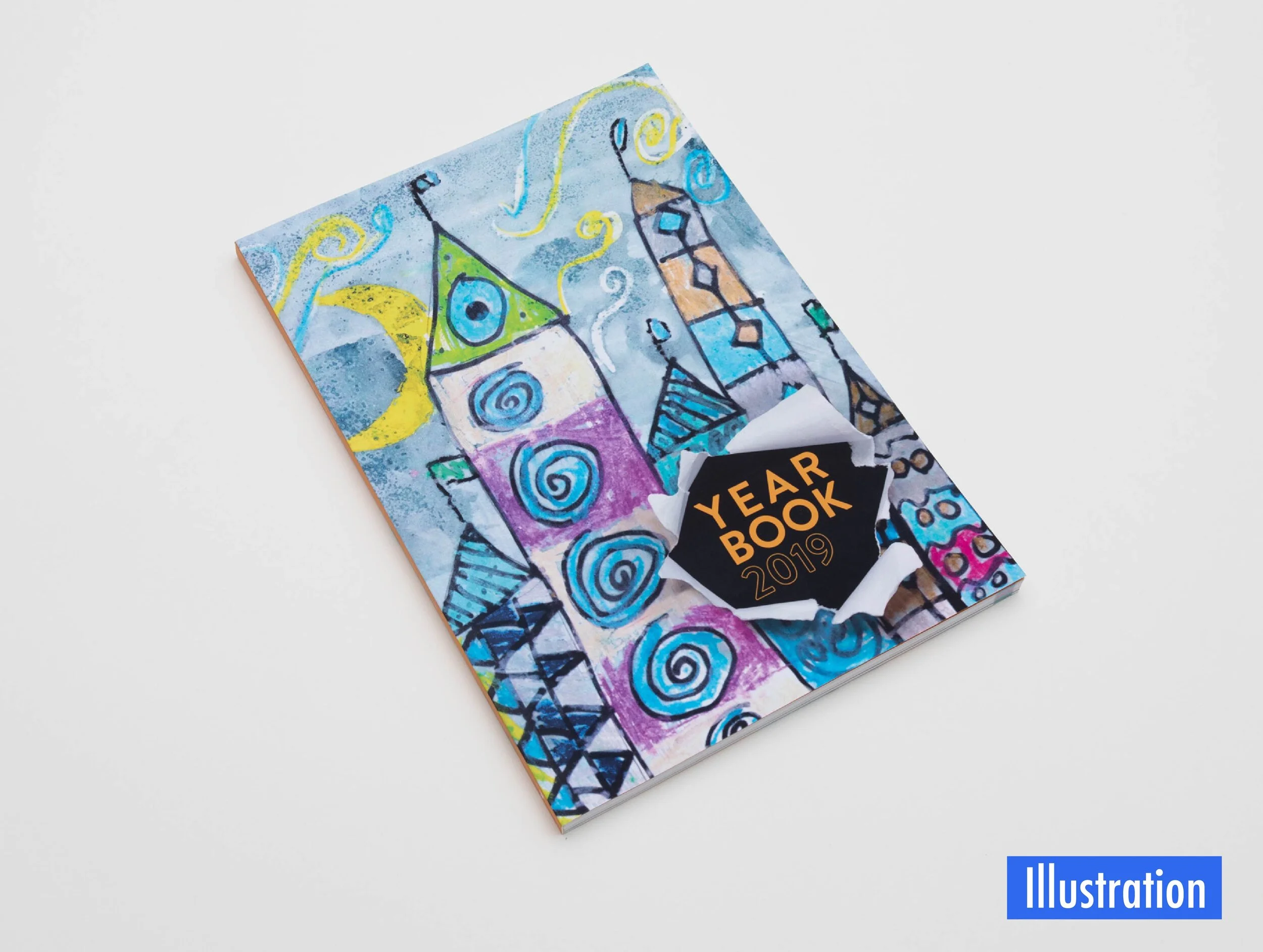A guide to yearbook covers
It’s something no one can help…we all judge a book by its cover. First impressions mean everything and your front cover is the first thing anyone sees. Your cover represents your school. We know thats daunting, and that’s why we’ve formulated this quick and easy guide to yearbook covers.
We’ve got you covered.
01. The Anatomy Of A Cover
In our 40 years of printing, we’ve seen it all when it comes to yearbook covers. There’s no right or wrong way, but here are some of the basic ingredients to consider throwing in the pot.
Front Cover
Front Cover Ideas
School name, logo, or motto
The year
Title or slogan
Organise a photo or illustration contest at your school and use the winning art as the cover masterpiece!
Use a special photo or hire a professional photographer for a unique shot.
Use graphic elements to create a unique composition.
Use a photo collage to show a snapshot of the year’s events.
Back Cover & Spine
Back cover ideas
School name, logo or motto
School contact information, such as phone number, mailing address and website.
Perhaps add an inspiring quote that represents your school spirit.
Spine
Usually it’s the school name, year, and the word ‘yearbook’
Pay attention to the direction of the text on the spine - usually the standard varies from region
02. Hard or Soft Cover?
It is important to understand each type of cover before choosing the best fit for your project.
Hard Covers
Printed paper case
A printed paper case is an alternative to cloth casing for hardbacks in which a paperback-like cover (but on much thinner paper) is glued on to the stiff boards and laminated in place. As a result, no protective dust jacket is necessary. A printed paper case can be used with a dust jacket if desired, and often both will use the same design. Many books only need a printed paper case.
Cloth
“Cloth-bound” generally refers to a hardcover book with cloth covering the outside of the book covers. The cloth is stretched over the boards, and is mainly to protect and shield the book from any damage. The cloth can then be printed on, embossed, or stamped for decorative and informative purposes.
Dust jacket
A Dust Jacket, also known as a Book Jacket or Dust Wrapper, is a printed paper overlay that wraps around the cover of a book. Dust jackets are most commonly associated with hardcover books, though you may occasionally see a jacket on perfect bound books as well. A dust jacket is an optional accessory. Also, it isn’t permanently attached to the book. It is merely held in place by flaps that fold around the front and back covers of the book. A dust jacket can be removed or reattached to a book very easily.
Soft Covers
One-sided board
One-sided board gives your book a stiff, more substantial cover, in comparison to silk or gloss coated boards. When using one-sided board your book’s cover is less likely to warp and bend over time. We believe one-sided board ‘feels’ better, and unless two-sided print is crucial to your project, this is one of the best options for your soft cover.
Silk & Gloss
Average weight for a softcover is 300gsm.
For printing on both the inner cover and outer cover of your book, silk or gloss coated boards is the option. Both sides of the paper are coated making silk or gloss covers heavier in weight, however more flimsy in comparison to one-sided board.
03. Cover Binding
While some may miss the small and considered details of binding, there is quite a lot of aesthetic pleasure that can be discovered in a beautifully-bound book.
Choosing the right style for your project can be a difficult task, especially when your bookbinding knowledge clouds your imagination.
Finding it daunting? That’s why we’ve built this helpful guide for writers, designers, photographers, illustrators, and creators so you can get a better understanding of what’s best suited for your book or magazine project.
Saddle Stitch
Saddle stitching refers to a binding process where pages are stapled together through the spine of the book.
The section is stitched a little over half a centimetre from the edge in two or more places, depending on the length of the publication. The stitched section then becomes the spine of the booklet, over which a cover may then be glued.
Common uses of saddle stitch binding
brochures
small booklets
programs
catalogues
calendars
pocket-size address books
some magazines
Advantages of saddle stitch binding
fast and more economical than many other methods
reliability
cost effectiveness
ability to gain closer access to the gutter of the binding margin
Make your saddle stiched project stand out by using contrasting coloured staples, like we did for our BOUND notebooks this year.
PUR binding
Perfect binding, also known as PUR binding, is a form of binding that uses glued inner pages and a wrap-around seamless cover like a paperback book. Perfect binding creates a long lasting, high quality spine for a book.
Perfect binding is generally used when a document is more than 5mm thick.
Common uses of PUR binding
‘how to’ books
catalogues
yearbooks
coffee table books
high quality magazines
journals
Advantages of PUR binding
requires less glue than EVA, yet still produces a stronger, more flexible bond
better choice for heavily coated stocks, wrong-direction grains, heavy ink coverage, and other materials that are hard to bind
the most versatile and durable print binding adhesive in use today
can be used with any type of ink or paper stock, allowing the widest variety of paper and finishing options
provides a lasting bind for books ranging from low to high page counts
Hardcover/Case Binding
Hard case binding (also known as hard cover binding) refers to the binding of a book in which a separate case bound cover is involved. The cover is non-flexible and is supported by a paper-back board, making it incredibly durable.
Common uses of hard cover / case binding
coffee table books
childrens books
recipe books
travel documentation books
Advantages of hard cover / case binding
very durable and unable to be bent as it is encased by a hard cover
the finished product has a classy and elegant look and feel
attract high retail prices
Singer Sewn Binding
Singer sewing is a beautiful, traditional method of bookbinding where a single thread (of any colour) is stitched through folded pages at the spine. With no adhesives or staples, this secure binding method is typically used on books with a single section. The stitching can either be visible on the outside or tucked neatly away on the inside.
Common uses of singer sewn binding
creative projects
journals
catalogues
notebooks
Advantages of singer sewn binding
Books can open flat all the time
Pages are securely bound together
Various thread colours are available
Different looks can be achieved
04. Cover Styles
It’s important to have a style in mind when designing your yearbook cover.
Some styles to consider include:
Illustration
Retro & Vintage
Cartoon
Full Page Photo
Graphic
Editorial Magazine
Pattern
Typography
Academic
Geometric
Photo Grids & Collage
Mixed Photo & Graphic
Minimalist
Posed
Novelty
My Yearbook Cover Styles
Be inspired by past My Yearbooks.
We hope you now feel comfortable designing your yearbook cover, and know what type of binding and cover options you would like.
Still feeling stuck? No worries, we have a team of yearbook designers that are eager to help.














